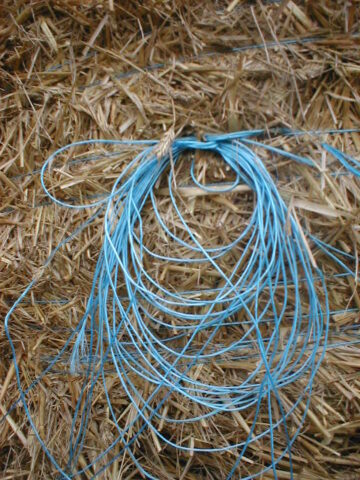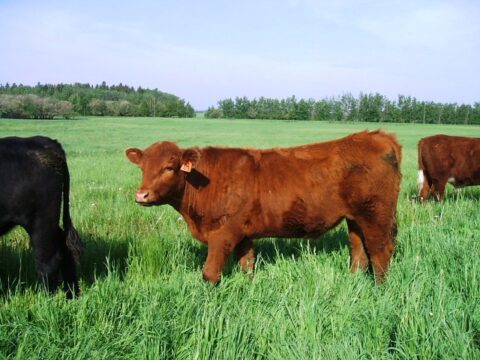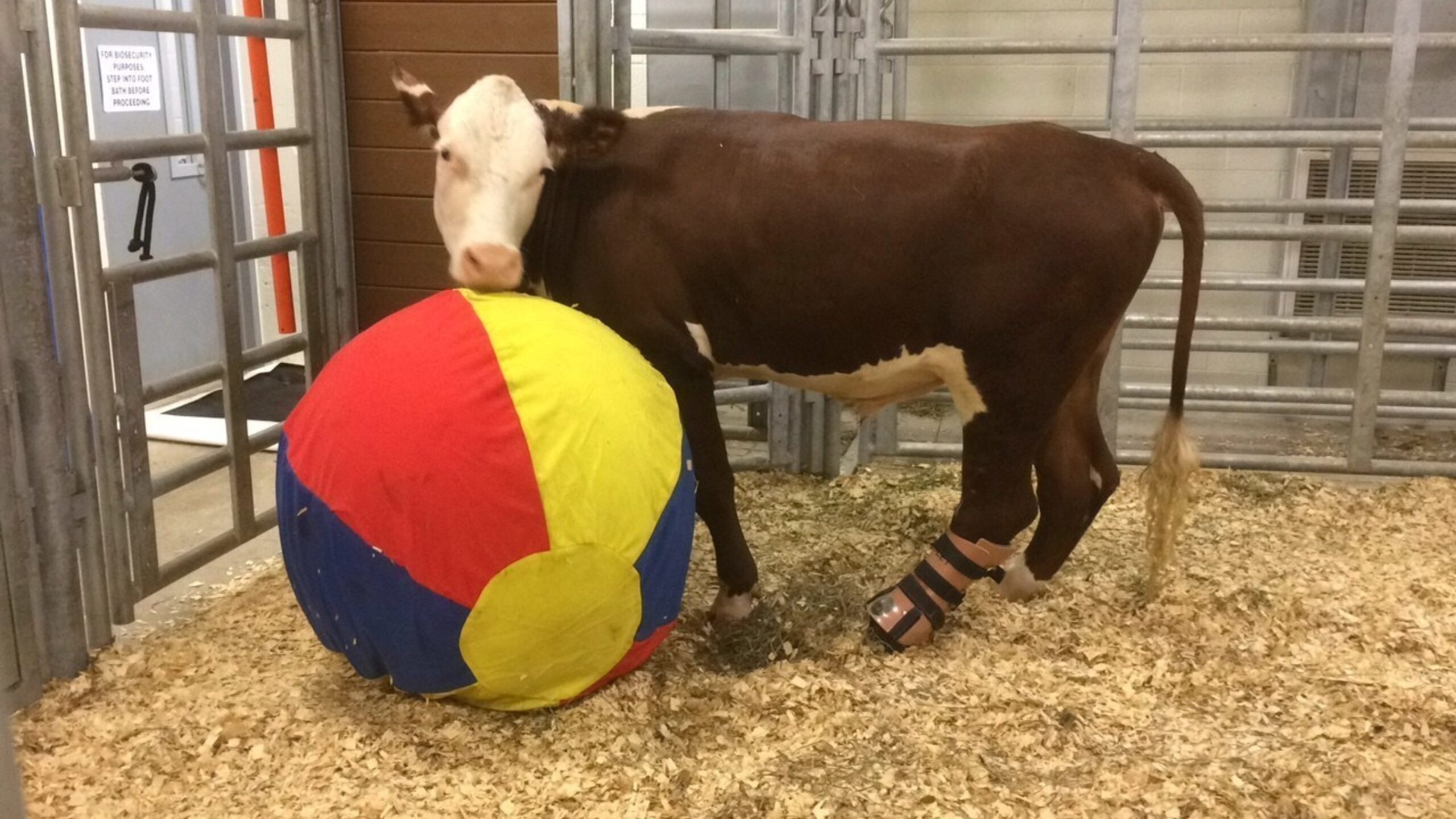Following my concerns with the Holstein cow Brianna from Skylands Animal Rescue, I thought I would bring up an old post from a couple of years ago about another bovine that was also rescued… but didn’t die of a ripe old age.
Why? Find out more below.
Gentle Barn Founder Ellie Laks announced Tuesday that Dudley, who had been having difficulty eating and defecating for a few days, died after “a ruptured ulcer tore apart his stomach.”
“There was nothing the surgeons could do to repair it,” Laks said in a Facebook post. “I don’t know why these things happen, I don’t know why extreme loss is a part of our earth experience, but I’m so deeply grateful to have been graced by Dudley over the last two years, and if we could do it all over again, we would.”
Source for quote: Knoxville News-Sentinel “Dudley, steer with prosthetic foot and mascot of Gentle Barn in Tennessee, has died”
Let’s make one thing clear before I launch into this blog post:
I am not a fan of the Gentle Barn. As a matter of fact, I’m not a fan of any “farm animal sanctuary.” As you’ll see below, these “sanctuaries” for farm animals are really nothing more than glorified petting zoos. Some are places, however, are pure hell for animals. The abuse in such places is passive-aggressive, where sheer neglect is profound in terms of giving nutritionally-adequate feed for the animals and ensuring clean living conditions. I have yet to bring that topic up in another article at another time.
Now that’s out of the way, this post, albeit a month late, needed to be written about Dudley, the Gentle Barn’s mascotized “rescued” Hereford steer. I had to give some thoughts as to what this bovine may have actually died of, and why the Gentle Barn may have actually lied about his death.
In order to do that, we need to start from the beginning.
In the Beginning…
According to GB, Dudley (a yearling bull at the time, prior to the rescue) was rescued with a severe infection or gangrene in his right hindfoot. This was from, supposedly (though it makes sense), baler twine wrapped around his fetlock (just above his hoof) for an extended period of time. He was found thin, and hobbling on three legs. The baler twine was wrapped so tightly around the fetlock that it completely cut off circulation.
Let’s stop right here and think about this.
I can understand how this would happen. There are times when life on the farm gets so busy that we sometimes forget to look in on the animals less often than what most may consider “optimal.” These animals are not house pets. They usually get looked at when it’s time to feed them, which may range from once a day to every few days.
When one comes up looking quite ill or lame, occasionally can be to the point where it’s almost too late. Most of the time, it’s not: a sick or injured animal gets the necessary veterinary treatment to get it better, at least as far as how much a farmer is willing to spend on saving an animal. Bovines are not cheap, so anything that can be feasibly done to save a sick or injured animal will be done. However, when a freak accident happens or an animal goes down with an illness so quick, or, worse still, gets diagnosed with an incurable illness, that leaves the farmer with no choice but to euthanize the animal. It’s the kindest thing to do, rather than leaving the animal to suffer because “an animal doesn’t want to die.”
In this case, I can only assume why Dudley had such an unfortunate circumstance happen to him. Was the farmer really that negligent in checking his animals? Or was it more a matter of leaving far too much baler twine behind? We’ll never know.

Plastic baler twine. Wikimedia Commons.
Just so you know, plastic baler twine is really tough stuff. It’s extremely hard to break and doesn’t decompose nearly as fast as sisal twine. It’s plastic. It remains in the ground for a very, very long time. Nasty stuff. So, when it gets wrapped around any bodily extremity, it’s so strong that it will indeed cut off the blood supply, acting like a tourniquet. The reason I know that is with this story:
Dad used baler twine as a tourniquet after dehorning steers to stem the blood flow. The only bad thing was that those steers had to be run through the squeeze chute again because the twine doesn’t fall off on its own. Finding out the hard way (poor steer[s]), if left for too long the baler twine cuts into the skull, where the skin grows over it, and the horns grow all weird too. Ick! Dad hated himself for making that dumb mistake; he really cared about those animals. So, he decided that the rubber rings used for canning jars worked best, because the rubber rots and eventually falls off on their own, and don’t cause as much gross damage as that damn plastic baler twine.
Back to the Dudlester.
So, the bull got “turned over” to GB instead of being slaughtered. He was put through quite a bit of surgery to get the hoof amputated, and a prosthetic foot replacement put on.
While in surgery, the bull got turned into a steer.
From all the photos I perused on Gentle Barn’s Facebook page, all this surgery was done while Dudley was put under general anesthesia.
The whole thing would’ve been extremely stressful on him. While I’m not a veterinarian, I’ve worked with one for a little while, long enough to understand the serious implications of putting a ruminant animal under. While it’s not impossible to do, it’s not good for them. Ruminant animals have a rumen that functions on regular contractions and burping once a minute to release the gases. Dogs, cats, and us humans do not have this forestomach (nor two additional forestomachs, the reticulum and omasum). Basically, general anesthesia disturbs normal rumen function. A ruminant can recover just fine if they’re put under once in a while–like only a few times in its entire life, if that–but not repeatedly over an extended period of time like what those vets were probably forced to do with the Dudlester. As you’ll read below, I have a suspicion that it was these many surgeries that partly resulted in Dudley’s eventual death.
The timeline for all of this, I believe, is that the bull was given to The Gentle Barn when he was ~10 months old (January 2015). Six months later (June 2015) he was brought to the Tennessee Gentle Barn sanctuary centre, being the very first resident of Gentle Barn’s Tennessee sanctuary. Every six months, he had to go in to get a new prosthetic over the next two years. Dudley died (was humanely euthanized) almost exactly two years later, in June 2017. In other words, he was 10 months old when surrendered to Ellie and the Gentle Barn crew, put through six months of multiple surgeries, and spent two years at GB Tennessee, making him three years and four months of age at his passing. He more than likely had more surgeries done to him prior to his death to fix his foot.
That means, for two years of his life, he was in awful, unnecessary, needless chronic pain from his amputated foot… and his respectively digestive issues.
Dudley’s Life at the Gentle Barn – The Dudley Story
A video released in 2017 by the Gentle Barn told Dudley’s story in a heart-string-pulling kind of way. Not for me. If you want to spend 17.5 minutes watching it, knock yourself out.
The video of the beginning of Dudley’s torment and torture shows you what the makers wanted you to see–in the beginning bull Dudley is limping severely, the end he’s bouncing around with his new foot like a young calf, being a very happy bovine with his new lease on life. However, as I perused Gentle Barn’s Facebook page on Dudley, I discovered some disconcerting evidence that was really disturbing to me.
One video on that page that clearly I remember was where Dudley was moving quite slowly, taking his time as he went (still maintaining quite a bit of a limp). They claimed he was just, “going where he wanted to go;” regarding his investigative behaviours of a typical bovine. But I could see he was hurting. As a typical bovine, he was making an effort to act tough and not show he was struggling much. He certainly had his caretakers fooled.
That was back around June or July of 2016.
During that time, up to when he went back to surgery again, he was obviously fed very well: good-quality hay, some grain, some grass, and even this new-fangled green algae or kelp stuff that were probably a source of minerals for him. I think he may have already had ulcers in his abomasum at that time, but it was really hard to tell.

Despite his shiny coat, this photo tells me that Dudley is not feeling good. His eyes look dull, his ears are down (not up and perky), and he’s definitely favouring his right hind leg. You can really see the muscles that have been built up in his left leg, and the significant lack of muscling in the right. That tells me that he hasn’t used his right hindfoot all that much, if at all; not putting the weight on it like a normal bovine would with four, normal, sound legs.
The fact that he doesn’t have much of a gut on him is partly because they’re feeding him so well. His body adjusted to the rich diet with a smaller gut. Cattle have bigger rumens when they eat more roughage. It could also partly be because he’s been undergoing a bit of chronic stress and pain, and not eating near as much forage as he should, even though he’s in decent condition. See, it’s that chronic stress and pain that’s got me convinced that’s what killed him in the end.
Moments up to and including Dudley’s Death
Dudley was put back in the large animal clinic of the University of Tennessee where he had originally had his surgeries and prosthetics put on. A couple of videos on GB’s Facebook page showed, undoubtedly, that the steer was in a whole lot of pain. I could see that, from what I’d seen earlier, the pain in his leg was worse now than it was.
According to the release by GB, Dudley was not “eating or pooping” as he should. This was followed by the announcement that Dudley had died of ruptured ulcers in his abomasum.
This is where those big, bright red flags were raised.
A bovine that has abomasal ulcers, according to Merck Veterinary Manual, does not become constipated. Here’s an excerpt from the veterinary experts (bolding is mine):
Cattle with bleeding abomasal ulcers may be asymptomatic except for intermittent occult blood in the feces, or they can die acutely from massive hemorrhage. Common clinical signs include mild abdominal pain, bruxism, sudden onset of anorexia, tachycardia (90–100 bpm), and fecal occult blood or melena that may be intermittent. Signs of blood loss are seen with major hemorrhage and may include tachycardia (100–140 bpm), pale mucous membranes, weak pulse, cool extremities, shallow breaths, tachypnea, and melena. More severe signs include acute rumen stasis, generalized abdominal pain with a reluctance to move and an audible grunt or groan with each breath, weakness, and dehydration. Melena may not be present in peracute cases, because it takes at least 8 hr for abomasal blood to be detected in the feces. As the condition progresses, body temperature drops, and the animal becomes recumbent and dies within 6–8 hr.
In general, bleeding ulcers do not perforate, and perforating ulcers do not bleed into the GI tract sufficiently to produce melena. However, hemorrhage and perforation are seen together occasionally, usually in cases that are chronic or associated with abomasal displacement.

A healthy steer with a healthy gut!
Dudley was most likely showing some form of anorexia. See that photo above again. Notice how his midsection was smaller than normal. Normally, healthy cattle have quite a fair size abdominal barrel on them. Dudley looked more like a bovine version of a Thoroughbred, with a bad leg. Dudley was not looking like a normal, healthy bovine.
Also, the Merck Vet Manual had no mention of constipation in the context of abomasal ulcers! The only way a bovine will become constipated is one of two ways:
- Internal parasites affecting the gastrointestinal tract (digestive system), or
- Consuming high-fibre, low-quality feed for a long period of time.
I very, very highly doubt that Dudley had either of the two afflictions.
That leads me to believe that Gentle Barn may have blatantly lied about the “not pooping” activity of the Hereford. Or, maybe they didn’t and there was a third underlying third cause, being that Dudley was so far along in his chronic state of pain and suffering that his guts were not working as they should be; basically, his rumen was starting to shut down, or he was in so much pain that eating was severely discomforting for him, so he stopped altogether. Hence the anorexia.
I certainly believe Dudley had abomasal ulcers. His not eating and skinny appearance showed that. The cause for him developing ulcers may have been due to several things:
- Chronic pain in his leg
- Feed was much too rich with not enough long-stemmed fibrous forage
- Compounding stress on his digestive system from going through multiple surgeries
- Other unknown factors not shown to the public
If he did have a ruptured ulcer, the perforation would not have “torn apart his stomach.” Instead, it would’ve caused a lot of internal bleeding. As Merck Veterinary Manual said above, this perforation and hemorrhaging are because of a chronic case of abomasal issues–as caused by the far-too-frequent surgeries. The Gentle Barn is notorious for stretching the truth, thus their claim is such that I don’t believe is true.
From all that had happened to the poor steer (being well and truly the innocent soul that was forced to go through all this unnecessary torment, despite the well-meaning efforts to “save” him), I have a very strong inkling that Dudley was humanely euthanized by the veterinarians, most likely against what the main Gentle Barn couple, Ellie and Ray, wanted for Dudley.
But it was what Dudley ultimately deserved. No: slaughtering him two and a half years ago would have been the much kinder option for him. It would have completely avoided forcing him to go through that much pain for that long.
In the end, Dudley was never saved. He was just placed into another place and forced to live through all that pain that he didn’t deserve to have.
Rest in peace Dudley. You’re in a much better place now, thank God.
